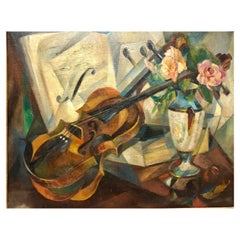Janice Biala
Early 20th Century American Modern Contemporary Art
Paint, Canvas
People Also Browsed
Vintage 1920s British Living Room Sets
Linen, Mahogany
2010s American Table Lamps
Brass
21st Century and Contemporary Contemporary Nude Paintings
Oil, Panel
Vintage 1970s English Mid-Century Modern Night Stands
Wood, Burl
Late 20th Century Italian Modern Wall Lights and Sconces
Brass
Vintage 1960s French Cabinets
Oak
Antique Early 19th Century Italian Regency Architectural Elements
Clay
1940s American Modern Landscape Prints
Woodcut
Vintage 1940s American Art Deco Lounge Chairs
Wrought Iron
Vintage 1940s Swedish Scandinavian Modern Cabinets
Brass
Antique 1890s English Late Victorian Cabinets
Satinwood
Antique 18th Century Italian Baroque Paintings
Canvas
Vintage 1920s French Art Deco Living Room Sets
Fabric, Upholstery, Lacquer, Palisander
Late 17th Century Old Masters Still-life Paintings
Cotton Canvas, Oil, Canvas
Vintage 1930s Italian Futurist Planters, Cachepots and Jardinières
Ceramic
18th Century Baroque Still-life Paintings
Canvas, Oil
Agnes Weinrich for sale on 1stDibs
Agnes Weinrich was one of the first American artists to make works of art that were modernist, abstract and influenced by the Cubist style. She was also an energetic and effective proponent of modernist art in America, joining with like-minded others to promote experimentation as an alternative to the generally conservative art of their time.
Weinrich was born in 1873 on a prosperous farm in southeast Iowa. Both her father and mother were German immigrants and German was the language spoken at home. Following her mother's death in 1879 she was raised by her father, Christian Weinrich. In 1905, they moved to Chicago, where Agnes studied at the School of the Art Institute of Chicago under John Vanderpoel, Nellie Walker and others. In 1909, Weinrich and Helen returned to Berlin and traveled from there to Munich, where Weinrich studied briefly under Julius Exter and on to Rome, Florence and Venice before returning to Chicago. Weinrich died in 1946.
A Close Look at Modern Furniture
The late 19th and early 20th centuries saw sweeping social change and major scientific advances — both of which contributed to a new aesthetic: modernism. Rejecting the rigidity of Victorian artistic conventions, modernists sought a new means of expression. References to the natural world and ornate classical embellishments gave way to the sleek simplicity of the Machine Age. Architect Philip Johnson characterized the hallmarks of modernism as “machine-like simplicity, smoothness or surface [and] avoidance of ornament.”
Early practitioners of modernist design include the De Stijl (“The Style”) group, founded in the Netherlands in 1917, and the Bauhaus School, founded two years later in Germany.
Followers of both groups produced sleek, spare designs — many of which became icons of daily life in the 20th century. The modernists rejected both natural and historical references and relied primarily on industrial materials such as metal, glass, plywood, and, later, plastics. While Bauhaus principals Marcel Breuer and Ludwig Mies van der Rohe created furniture from mass-produced, chrome-plated steel, American visionaries like Charles and Ray Eames worked in materials as novel as molded plywood and fiberglass. Today, Breuer’s Wassily chair, Mies van der Rohe’s Barcelona chair — crafted with his romantic partner, designer Lilly Reich — and the Eames lounge chair are emblems of progressive design and vintage originals are prized cornerstones of collections.
It’s difficult to overstate the influence that modernism continues to wield over designers and architects — and equally difficult to overstate how revolutionary it was when it first appeared a century ago. But because modernist furniture designs are so simple, they can blend in seamlessly with just about any type of décor. Don’t overlook them.
Finding the Right Folk-art for You
Folk art refers to a genre of art that shares the creator’s traditions, offering not just an artistic display but an opportunity to learn about a culture. Vintage, new and antique folk art typically reflects a heritage or location. It can include utilitarian objects and handmade art as diverse as weather vanes, portraiture and paintings, carnival art, quilts and duck decoys.
American folk art is frequently valued because of the traditional skills involved, like weaving, hand-carving wood and even stonework. Many folk artists are self-taught, while some train as apprentices within their community. By using available materials and taking a personal approach to their creations, artists ensure each piece is unique and conveys a story. Native American folk art includes functional objects reflecting their heritage, such as baskets, textiles and wooden pieces.
During the Great Depression, artistic materials in America were hard to come by, so artisans used discarded wood from cigar boxes and shipping crates to make highly stylized, notched pieces — most often picture frames and boxes — that are today sought after by collectors. This folk art style is called tramp art and was popular from roughly 1870 until the 1940s.
Folk art brings vibrant culture and traditions into your home. Browse an extensive collection of folk art on 1stDibs.
